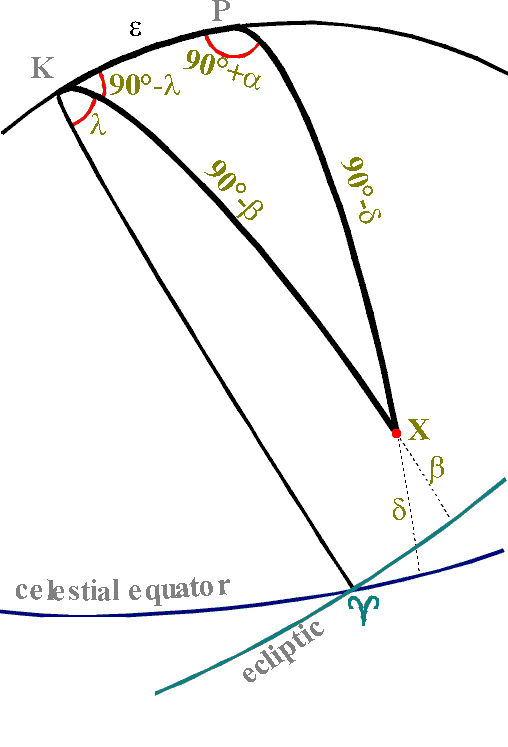-
"الفلك الموضعي"
- مقدمة
- الكرة الأرضية
- هندسة المثلثات الكروية
- ملاحظات حول الهندسة الكروية
- إحداثيات أفقية "alt-az"
- إحداثيات استوائية "HA-dec"
- إحداثيات استوائية "RA-dec"
- الزمن النجمي
- الانتقال بين أفقي و استوائي
- إحداثيات مجرية
- إحداثيات بروجية
- الانتقال بين بروجي و استوائي
- حركة الشمس و ضبط الوقت
- القمر
- الإنكسار الجوي
- شروق و غروب الشمس، الشفق
- اختلاف المنظر المركزي اليومي
- اختلاف المنظر الموسمي
- الزيغ
- المبادرة و الترنح :اضطراب محور الأرض
- تقاويم
- الامتحان الأخير
- الإحداثيات الفلكية، خضر الأحمد
- الحركة الظاهرية للنجوم (تفاعلي)
- الأقطاب السماوية (تفاعلي)

الصلة بين الاحداثيات البروجية و الاستوائية
{Note: If your browser does not distinguish between "a,b" and "α, β" (the Greek letters "alpha, beta") then I am afraid you will not be able to make much sense of the equations on this page.}

Draw the triangle KPX,
where P is the North Celestial Pole,
K is the
north pole of the ecliptic,
and X is the object in question.
Apply the cosine rule: cos(90°-δ) = cos(90°-β) cos(ε) + sin(90°-β) sin(ε) cos(90°-λ)
i.e. sin(δ) = sin(β) cos(ε) + cos(β) sin(ε) sin(λ)
Alternatively, apply the same rule to the other
corner, and get:
cos(90°-β) = cos(90°-δ) cos(ε) + sin(90-δ) sin(ε) cos(90°+α)
i.e. sin(β) = sin(δ) cos(ε) - cos(δ)
sin(ε) sin(α)
Now try applying the sine rule to the same triangle,
sin(90°-β) / sin(90°+α) = sin(90°-δ) / sin(90°-λ)
i.e. cos(λ) cos(β) = cos(α) cos(δ)
تمرين:
Aldebaran has Right Ascension
4h36m, declination +16°31'.
What are its ecliptic coordinates?
الحل:
- احداثيات بروجية
ترجمة قتيبة أقرع
- الشمس و ضبط الوقت